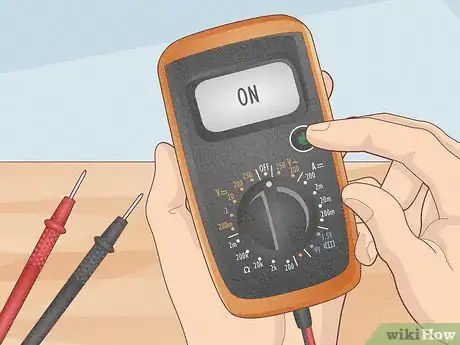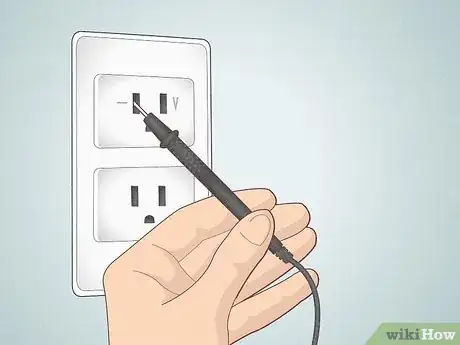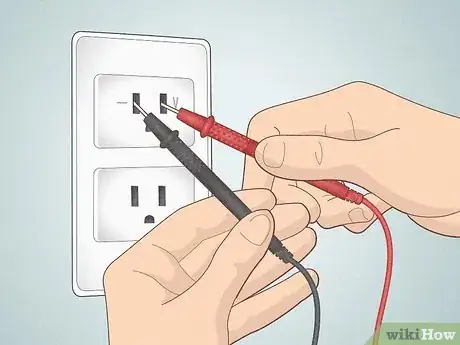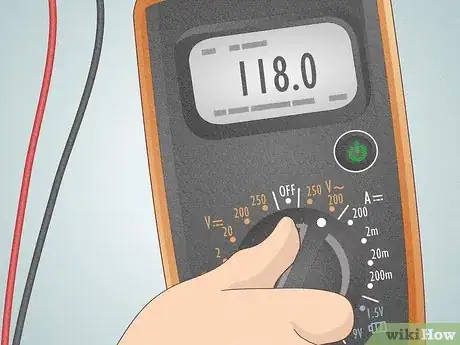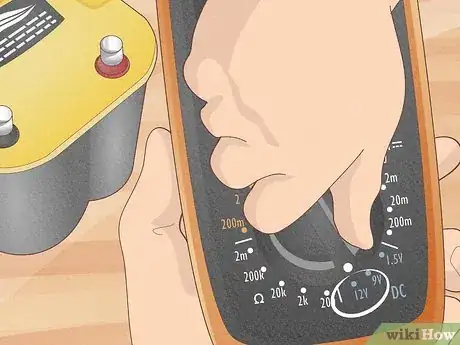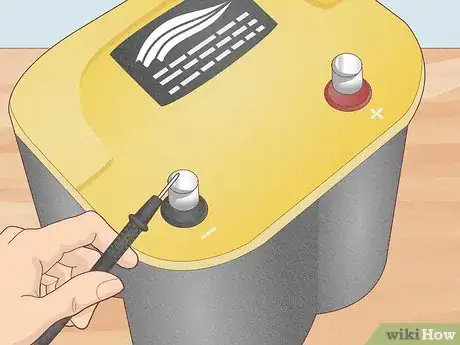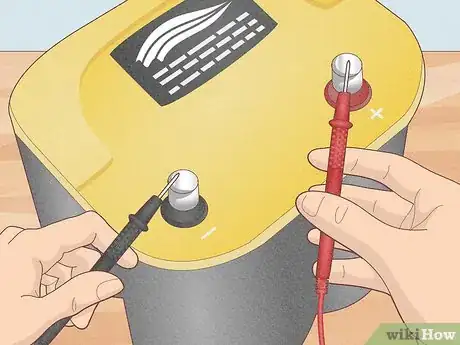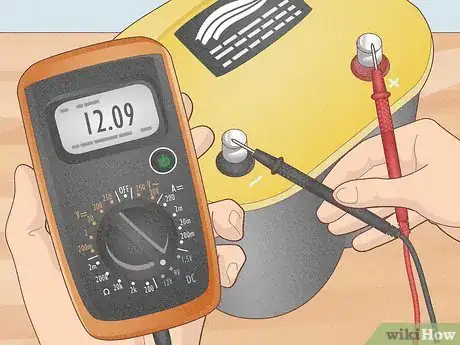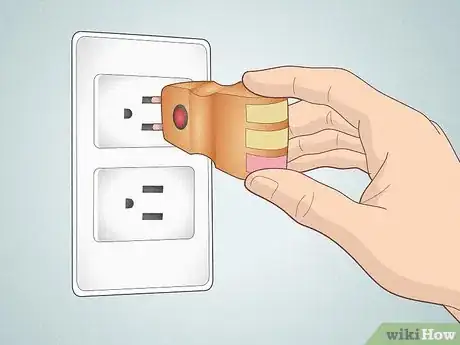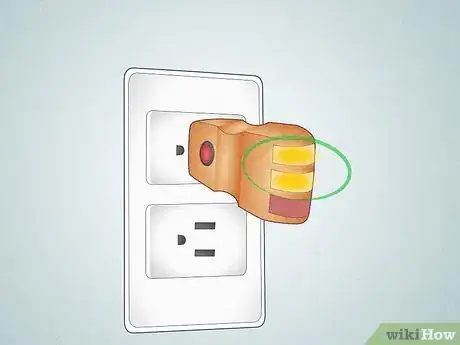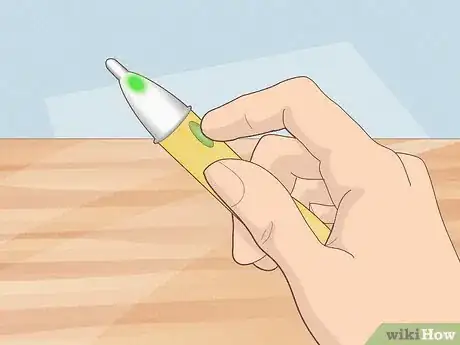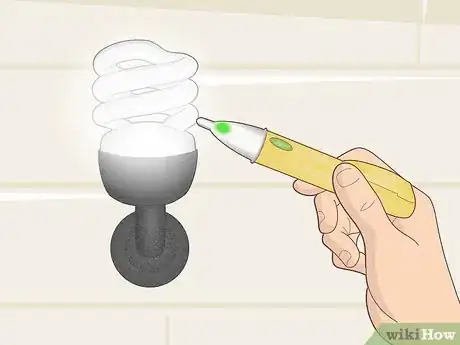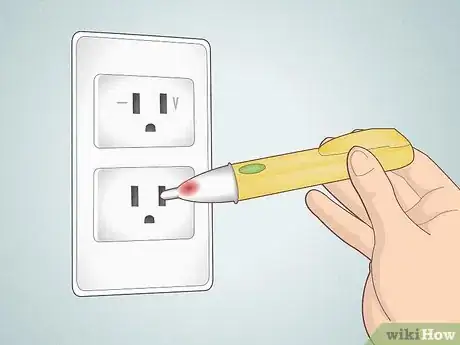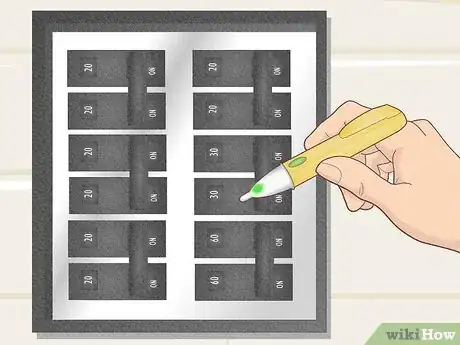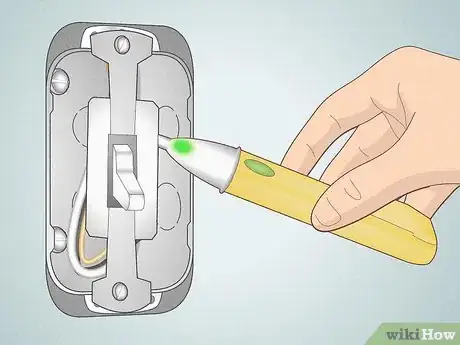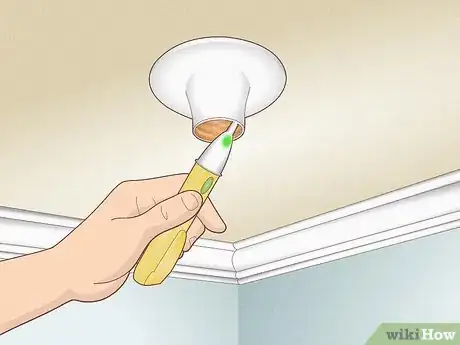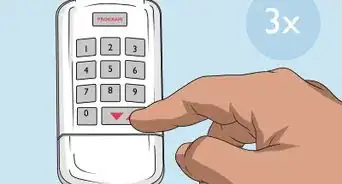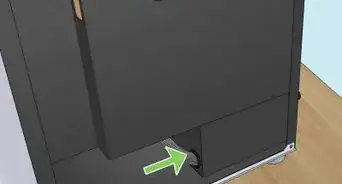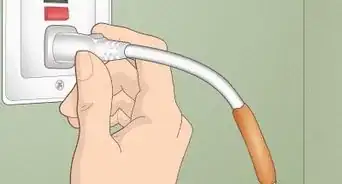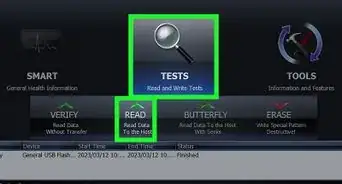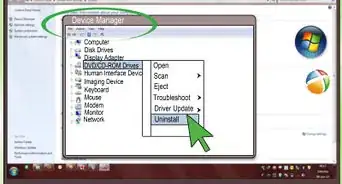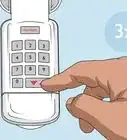This article was written by Mantas Silvanavicius and by wikiHow staff writer, Travis Boylls. Mantas Silvanavicius is a Licensed Electrician and the Owner of M+S Electric based in Las Vegas, Nevada. With more than 20 years of experience, he specializes in home electrical installations, testing, and wiring. Mantas and his team have completed projects for companies such as Seiko and Springhill Suites by Marriott. M+S Electric is licensed, bonded, and insured.
This article has been viewed 99,486 times.
Voltage testers are used to detect an electrical current in electrical outlets, light switches, circuit breaker panels, light fixtures, and other electrical components. This helps determine if the electrical components are working properly. They can also be used to tell if electrical wires and components are safe to handle. There are a few different types of voltage testers you can use. Multimeters are used to test the exact voltage of an electrical current. Outlet testers can tell you if there are any wiring problems with an electrical outlet, and non-contact voltage testers can safely tell if an electrical current is present without having to make contact with live wires or components. This wikiHow article teaches you how to use voltage testers.
Things You Should Know
- Use a multimeter to measure alternating current (AC) or direct current (DC).
- If you just need to test the voltage of an outlet, use an outlet tester. They report the status of the outlet.
- For testing voltage without touching electrical components, use a non-contact voltage tester.
Steps
Using a Two-Lead Probe (Multimeter)
-
1Plug in the multimeter and power it on. A multimeter is a two-lead voltage tester that tells you exactly how much voltage it is reading. Plug in the multimeter and power it on.
-
2Plug the black probe into the "COM" or "-" port. The black probe is used to measure the ground or neutral wires. Connect this to the port that says "COM" or has a minus (-) sign next to it.Advertisement
-
3Connect the red wire to the voltage port. Typically the voltage port with a capital "V" next to it. The red probe is used to connect to the hot wire, which is the wire that carries the electrical current.
- Some multimeters have a port that says "10A" next to it. This is used to measure large electrical currents up to 10 amps.
-
4Select the voltage mode. Most multimeters have a dial on the front. This allows you to select the mode, as well as the range of measurement you are expecting to take. Turn the dial so that it is in alternating current (AC) or the direct current (DC) mode. AC is usually indicated by a V with a wavy line next to it. Direct current is usually indicated by a V with a straight line next to it.
- Some multimeters also allow you to measure Amps and Ohms in addition to voltage.
-
5Select the voltage range. In order to get the most accurate reading, you'll need to turn the knob to place the voltage reading within the range you are expecting to receive. For example, if you are testing a 9V battery, selecting 20 volts on the dial will give you a more accurate reading than 2000 volts. The following are common voltages:
-
6Place the black probe on the ground, neutral wire, or negative terminal. If you are testing a battery, place the black probe on the negative terminal. It is usually labeled with a minus (-) sign. If you are testing an electrical outlet, place the black probe in the large slot. If you are testing electrical wiring, touch the black probe to the exposed white or green wire.
- You can also purchase accessories for your probes, such as alligator clamps or banana plugs.
-
7Place the red probe on the hot wire or positive terminal. If you are testing a battery, place the red probe on the positive terminal. It is usually labeled with a plus (+) sign. If you are testing an electrical outlet, place the red probe in the small slot. If you are testing wiring, touch the red probe to the exposed black wire.
-
8Read the meter. The display should display how many volts it is receiving.
Using an Electrical Outlet Tester
-
1Plug the voltage tester into the outlet. Outlet testers are the simplest type of voltage tester to use. They plug directly into an electrical outlet. They have three lights and a chart that indicates if there are any problems with the electrical outlet.
-
2Read the results. Most electrical outlet testers have three lights. There is usually a key on the side of the tester that indicates what the lights mean. Typically, the red light indicates voltage to the ground (green) wire. The first yellow light indicates voltage to the neutral (white) wire, and the second yellow or white light indicates voltage from the hot (black) wire. The hot wire is the wire that carries the electrical current. The following are some common readings:[3] [4]
- Correct: If both yellow lights are lit up and the red light is dark, this indicates that the outlet is working in most cases. If either the hot or neutral lights are dim, this indicates that the wire is in poor condition.
- Open Hot: If all lights are dark, this indicates that there is no electricity coming from the hot (black) wire. Electricity may be shut off, or the wire may be disconnected, or bad.
- Open Neutral: If the second yellow light is lit, but the red and first yellow lights are dark, this indicates that the neutral wire is not getting any electricity. The neutral (white) wire may be disconnected or need to be replaced.
- Open Ground: If the first yellow light is on, but the second yellow light and the red light is dark, this indicates that the ground wire is not getting any electricity. The ground (green) wire may be disconnected or need to be replaced.
- Reversed Polarity: If the red light and the first yellow light are lit, this indicates that the hot and neutral wires are reversed. The outlet needs to be re-wired so that the hot and neutral wires are switched. The hot wire wired to the ground could also give this reading.
- Hot and Ground Reversed: If the red light and second yellow light is lit, but the first yellow light is dark, this indicates that the hot and ground wires are reversed. It could also indicate that the neutral wire is bad and the polarity is reversed. If you get this reading, the entire outlet needs to be re-wired.
Using a Non-Contact Voltage Tester
-
1Power on the non-contact voltage tester. Non-contact voltage testers can detect an electrical current without having to touch any live wires or electrical components. This makes them safer to use than other voltage testers. Press the power button on your voltage tester to turn it on.[5]
- Some non-contact voltage testers require you to press and hold a button to power it on. The device will either chirp, display a light, or both to indicate that it is on.
-
2Test the voltage tester on a working light. This confirms the non-contact voltage tester is working properly. To test the non-contact voltage tester, place the tip of it in the short slot of an electrical outlet, or touch the cord or bulb of a lit lamp.
-
3Test an electrical outlet. To test an electrical outlet with a non-contact voltage detector, touch the tip of the non-voltage detector to the small slot on the receptacle of the electrical outlet. It's also a good idea to test the large slot on the receptacle to make sure the outlet is wired properly.
-
4Test a breaker switch. To test a breaker switch, simply touch the tip of the non-contact voltage detector to the switch in the panel of a breaker box.
-
5Test a light switch. To test a light switch, make sure the switch is turned on. Unscrew the faceplate from the wall. Then touch the tip of the non-contact voltage detector to the screw terminals on the side of the light switch.
- Once you confirm a light switch does not have a live electrical current, it is safe to remove the light switch
- When testing a three-way switch, be sure to test all screw terminals on both switches before continuing.
-
6Test a light fixture. Turn on the light switch to the light. Unscrew the light-bulb and place the tip of the non-contact voltage detector inside the light socket. If the light has a three-way switch, be sure to test the light with the switch in both the up and down position.[6]
- Once you confirm that the light fixture does not have an electrical current, it is safe to remove the light fixture from the ceiling.[7]
Community Q&A
-
QuestionWhat is the easiest and safest way for a homeowner to check if a gadget has been fully switched off from the mains?
 Community AnswerThe easiest way to do this is with a voltage tester, which you can buy at an electronics or hardware store.
Community AnswerThe easiest way to do this is with a voltage tester, which you can buy at an electronics or hardware store. -
QuestionHow do I use a voltage tester to check incoming voltage in a distribution box?
 Community AnswerIt seems different, but it is the same as any voltage test. If you need to get into the power input wire, turn the breaker off for that box, open the wire to get to the metal inside, and then turn it back on. It is still a regular voltage for a power outlet.
Community AnswerIt seems different, but it is the same as any voltage test. If you need to get into the power input wire, turn the breaker off for that box, open the wire to get to the metal inside, and then turn it back on. It is still a regular voltage for a power outlet. -
QuestionHow do I know if my outlet is bad?
 Community AnswerIf it sparks, smokes or doesn't work.
Community AnswerIf it sparks, smokes or doesn't work.
Warnings
- Contact a licensed electrician if you are not experienced with electrical repairs.⧼thumbs_response⧽
References
- ↑ http://www.evergreencpusa.com/alkaline-battery-specifications
- ↑ https://www.autobatteries.com/en-us/battery-testing-and-maintenance/car-battery-voltage-and-testing
- ↑ https://www.youtube.com/watch?v=mjnGkex4dxQ&t=88s
- ↑ http://thecircuitdetective.com/outlet_tester_readings.php
- ↑ https://www.youtube.com/watch?v=MlPn1K32E8Q
- ↑ https://www.instructables.com/How-to-Use-a-Non-Contact-Voltage-Tester/
- ↑ https://www.youtube.com/watch?v=MlPn1K32E8Q
About This Article
1. Connect the black prove to the "COM" or "-" port.
2. Connect the red probe to the voltage "V" port.
3. Select AC or DC mode on the dial.
4. Select the appropriate voltage range you are testing.
5. Place the black probe on the negative terminal, ground, or neutral wire.
6. Place the red probe on the positive terminal or hot wire.
